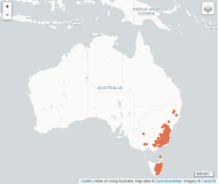| Scleranthus fasciculatus | |
|---|---|

| |
| Conservation status | |
 Vulnerable (IUCN 3.1) | |
| Scientific classification | |
| Kingdom: | Plantae |
| Clade: | Tracheophytes |
| Clade: | Angiosperms |
| Clade: | Eudicots |
| Order: | Caryophyllales |
| Family: | Caryophyllaceae |
| Genus: | Scleranthus |
| Species: | S. fasciculatus |
| Binomial name | |
| Scleranthus fasciculatus (Labill.) Hook.f. | |

| |
Scleranthus fasciculatus, commonly known as spreading knawel, is a rare, spreading, non-woody herb found in the south-eastern states of Australia and introduced to New Zealand. The species is found in dry grassland habitats and requires the maintenance of inter-tussock spaces for its establishment and persistence. A number of anthropogenic factors have contributed to the species decline such as impacts from land clearing, road construction and maintenance, and herbicide application.
Description

Scleranthus fasciculatus is a prostrate spreading perennial herb. Stems are non-woody and tend to be hairy, up to 30 cm (12 in) in length. Leaves are commonly hairy, linear, and papillose, tapering to a point and occur in clusters. The inflorescence consists of a pair of small pedunculate yellow/light green sub-sessile flowers held by bracts. Flowers have five sepals (0.4–0.7 mm (0.016–0.028 in) long) that overlap at the base and no obvious petals. Flowering occurs in September to March. The fruit is enclosed within a perigynium and calyx and takes the form of an ovate indehiscent nutlet containing one ovoid seed.

Scleranthus fasciculatus is similar in form to Scleranthus biflorus, an Australian native and commonly cultivated landscaping plant, but it does not form dense cushion-like mats characteristic of the latter species.
Habitat and distribution
Scleranthus fasciculatus grows as a native in the Australian states of Victoria, New South Wales (NSW), the Australian Capital Territory, and Tasmania. It has been introduced to New Zealand.
In Tasmania S. fasciculatus is common to silver tussock (Poa labillardierei) grasslands and grassy woodlands where it grows in gaps between the tussocks alongside many other herbaceous plants that are native to these habitats. Silver tussock grasslands are a subcategory of Tasmanian Lowland Native Grasslands, found in the Midlands, east Coast, Derwent Valley, and southeast of Tasmania. These grasslands are typically common in areas of low rainfall where the soils are deep and fertile, and occur in areas with basalt or dolerite geology.
On mainland Australia the species occurs in Montaine forest and woodlands. It has been observed in the Victorian Tablelands, Kosciuszko National Park, and the western mountains of NSW.
Threats and conservation
Scleranthus fasciculatus is classified as vulnerable in Tasmania and endangered in Victoria.
Tasmanian Lowland Native Grasslands and are classified as a nationally threatened ecological community, and critically endangered in Tasmania. Since European settlement in Tasmania in 1803 there has been extensive clearing of Lowland Native Grasslands amounting to the decline of many species found within them, including S. fasciculatus. Remnants of this vegetation type are located on private property, in some local reserves, in cemeteries or along roadsides. Fire plays a large role in the species persistence as it maintains inter-tussock gaps where the species persists. Threats to S. fasciculatus include land clearing, inappropriate regulations of fire regimes, inappropriate grazing, invasion of weeds, and adverse impacts from herbicide and road construction and maintenance.
Conservation efforts focus on the implementation of appropriate fire and grazing regimes that benefit the ecological community. There is also a focus on controlling introduced deer populations in the Australian Alps to preserve S. fasciculatus and other species and communities that are threatened by their presence.
References
- ^ "Key to Tasmanian Vascular Plants". University of Tasmania. 2019. Retrieved 27-03-2024.
- ^ Threatened Species Section (2024). spreading knawel (Scleranthus fasciculatus): Species Management Profile for Tasmania's Threatened Species Link. https://www.threatenedspecieslink.tas.gov.au/Pages/Scleranthus-fasciculatus.aspx Department of Natural Resources and Environment Tasmania. Accessed on 27/3/2024.
- VicFlora (2024). Scleranthus fasciculatus. Flora of Victoria, Royal Botanic Gardens Victoria. Available online: https://vicflora.rbg.vic.gov.au (accessed on: 27 Mar. 2024).
- ^ PlantNET (The NSW Plant Information Network System). Scleranthus fasciculatus. Royal Botanic Gardens and Domain Trust, Sydney. https://plantnet.rbgsyd.nsw.gov.au
- Schmid, Rudolf; Walsh, N. G.; Entwisle, T. J. (May 2000). "Flora of Victoria. Vol. 4. Dicotyledons: Cornaceae to Asteraceae". Taxon. 49 (2): 344. doi:10.2307/1223869. ISSN 0040-0262. JSTOR 1223869.
- Breitwieser I., Heenan P.J.; Nelson W.A., Wilton A.D. eds. (2010–2024) Flora of New Zealand Online – Weed Profile – Scleranthus fasciculatus (based on Heenan 2010). Accessed at http://www.nzflora.info/factsheet/Weed/Hypericum_androsaemum.html, 02/04/24
- ^ Department of the Environment, Water, Heritage and the Arts (2010). Lowland Native Grasslands of Tasmania — a nationally threatened ecological community. Environment Protection and Biodiversity Conservation Act 1999 Policy Statement 3.18. Australian Government, Canberra.
- Atlas of Living Australia website. Specie page: https://bie.ala.org.au/species/https://id.biodiversity.org.au/node/apni/2917818. Accessed 3 Apr. 24
- "Early colonial administration records - Introduction". libraries.tas.gov.au. Retrieved 1 April 2024
- Claridge, A.W. (2016) Threatened flora at potential risk from introduced deer in the Australian Alps. A final report to the Australian Alps Liaison Committee. NSW National Parks and Wildlife Service, Queanbeyan NSW 2620, Australia.